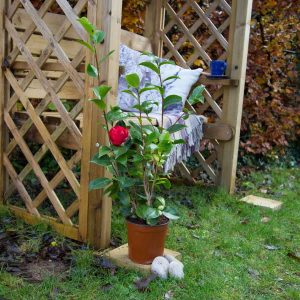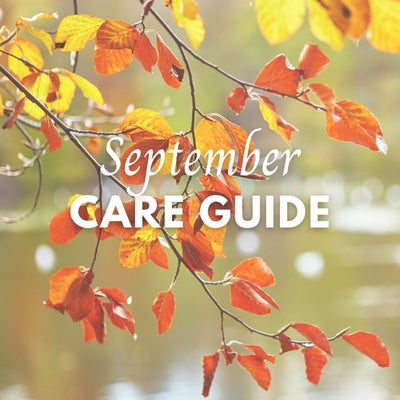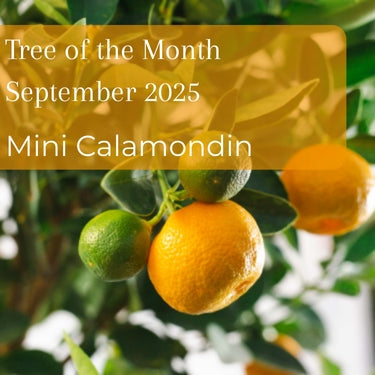How to care for camellia plants
Quick Facts:
- Latin name: Camellia
- Hardiness: Fully hardy. Suitable for growing across the UK and Ireland
- Height: 2.5m / 8.2ft dependent on variety and pruning
- Flowering: Winter and spring
- Suitable for: Planting
- Also suitable for: Pot growing
- Difficulty: Easy
Camellias are beautiful flowering evergreen plants that will bring a splash of colour to the garden even in deepest, darkest winter. These hardy plants naturally grow in woodland, so will love a location that offers dappled sun and shade.
When you receive your camelia plant, it's important that you remove it from the outer packaging immediately and put it in a suitable place in the garden until you're ready to plant it in spring or autumn.
Soil
 A big part of growing camellias successfully is ensuring you have the correct soil. They thrive in acidic loamy soil with a PH balance between 5 and 6 and good drainage. If your soil isn't a suitable acidity, you could make it more acidic with the addition of sulphur, but this will need to be done a year in advance and retested to check the PH balance is now appropriate.
A big part of growing camellias successfully is ensuring you have the correct soil. They thrive in acidic loamy soil with a PH balance between 5 and 6 and good drainage. If your soil isn't a suitable acidity, you could make it more acidic with the addition of sulphur, but this will need to be done a year in advance and retested to check the PH balance is now appropriate.
If this all seems a little too much like hard work, you could always grow your camellia plant in a pot, which would allow you to control the plant's microclimate. Use John Innes Ericaceous Compost or other ericaceous soil to pot them in - other general soils and composts wpn't be suitable.
Planting
 If the soil in your garden is suitable and you're planting your camellia plant in the ground, choose a planting site that gets dappled sunshine and plenty of shade and sheltered from strong wind and frost. Plant your camelia in spring or autumn.
If the soil in your garden is suitable and you're planting your camellia plant in the ground, choose a planting site that gets dappled sunshine and plenty of shade and sheltered from strong wind and frost. Plant your camelia in spring or autumn.
An hour before planting, water the pot thoroughly. Remove the plant from its container and gently tease out the roots. Prune any that are damaged or broken. Dig a hole roughly three times the width of the tree's roots, but no deeper. Then plant the tree before backfilling any gaps with a mix of soil and organic leaf matter.
Add a tree guard for protection from rabbits and other small animals.
Repotting
If you've chosen to grow your camellia plants in pots, we suggested using John Innes ericaceous compost.
Repot your camellia every couple of years into larger container so it's not restricted, until it reaches a desirable size. Remember to always choose deep pots with drainage holes as camellias prefer well-draining soil. Look out for the following signs that your camellia is ready for a more spacious home:
- Does the plant look less healthy than it used to?
- Does it seem to dry out quicker?
- Are there roots growing out of the holes in the bottom of the pots?
Some tips for repotting:
- Always use a soil or compost designed for ericaceous plants, or with a PH balance of 5-6.
- The soil around the plants should be slightly moist; water thoroughly an hour before repotting to achieve this.
- Loosen the soil around the edge of the pot and pull the blueberry out by the base of the main stem
- If you're moving the plant to a bigger pot, add some extra soil into the bottom of the pot before you insert the plant
- Fill with your chosen soil or compost
- Water the plant thoroughly, and keep it well watered for several weeks
Once the plant is fully grown, repotting it may be a big job. Instead, you could think about replacing 30-50% of the compost every other year, so the tree doesn't exhaust its supply of nutrients.
Feeding
Feed your camelia with an acidic fertilizer such as Miracle Gro Continuous Release Ericaceous Plant Food through spring and early summer.
Watering
 Camellia plants growing in the ground will require a regular supply of water when they're growing, or when they have formed flower buds, to ensure the flowers open. If conditions are dry, it's advisable to water your camellia using rainwater rather than tap water whenever possible.
Camellia plants growing in the ground will require a regular supply of water when they're growing, or when they have formed flower buds, to ensure the flowers open. If conditions are dry, it's advisable to water your camellia using rainwater rather than tap water whenever possible.
When plants are grown in containers, they'll have more restricted access to water than those growing in the garden so will need watering with greater regularity.
Mulching
Mulching is the term used for the layer of organic material that is placed on top of the soil around your plants every year. It has a whole host of benefits, including keeping the soil moist throughout summer and discouraging blackspot and weeds. The best time to mulch around camellias is in late winter or early spring.
First, prepare the ground by removing debris and weeds and water the surface of the soil if it's dry, then apply a thin layer of well-rotted manure all around the plant.
Pruning
Prune your camellia in the spring, as soon as it has finished flowering by snipping the ends of the branches back to the desired size.
Winter Care
Protect camellia plants from low temperatures and frosts with horticultural fleece.


